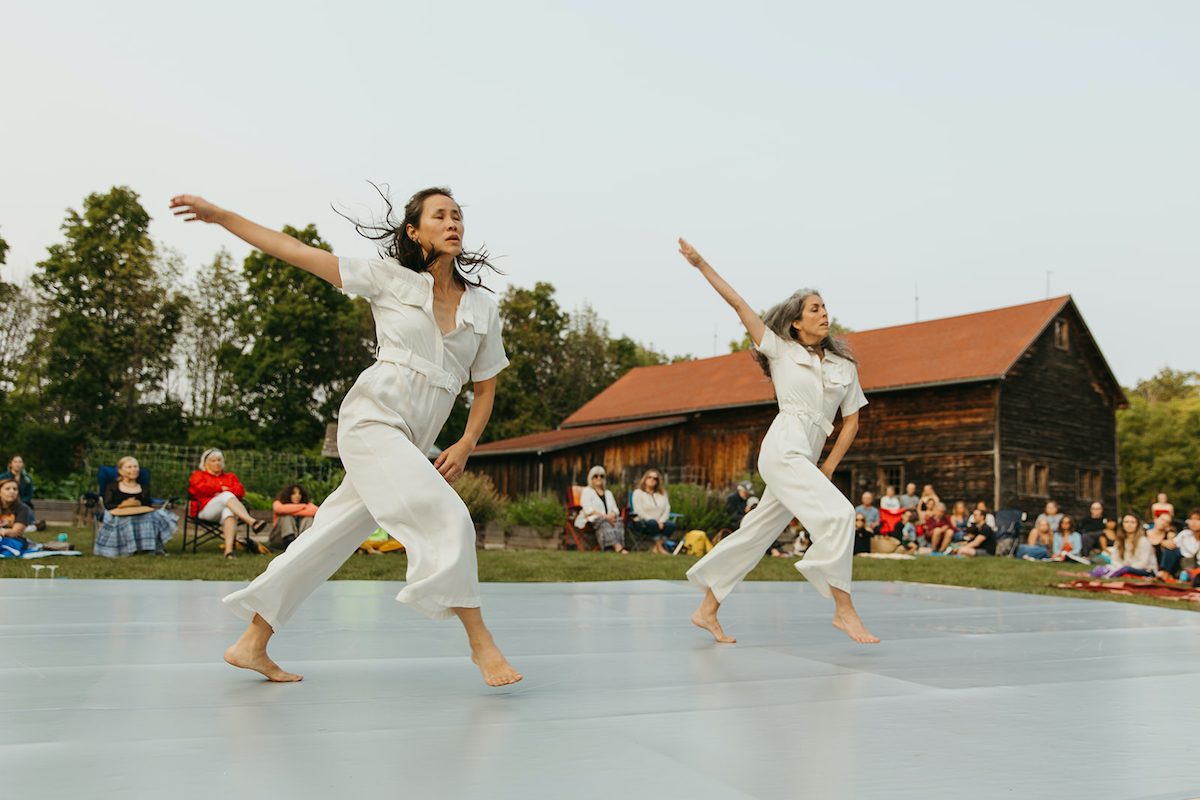TRAVERSE CITY, MI —The Midwest deserves its own landmark dance festival. Two grassroots initiatives—on opposite coasts of Lake Michigan—are trying to make it happen.
To be clear, there are festivals. For almost two decades, Dance St. Louis has hosted the Spring to Dance Festival, a robust operation reduced to just two days and two performances since the pandemic. More examples abound: There’s RAD Fest in Kalamazoo, the brand-new No Dance Fest in Milwaukee and Harvest Chicago Contemporary Dance Festival, to name a few. The now-defunct Chicago Dancing Festival put on a full week of free dance at a handful of downtown venues for 10 years.
But that’s not quite what I mean. The east coast is flush with destination festivals (like Jacob’s Pillow, American Dance Festival and Bates Dance Festival), bringing artists from across the country together in an idyllic, off-the-beaten-path locale to train, teach and enjoy some of the best dance. The model can vary a little place to place; key to their success, though, is a training element—bringing in students eager to learn from those artists and fill houses alongside community members.
Death’s Door Dance Festival in Door County, Wis. is a miniature version of this, with a series of workshops, master classes and outdoor performances taking place over a long weekend in July. The most public-facing element is a showcase at the park pavilion in Sister Bay—right in the heart of Door County’s vacation central. Thus, the crowd is a combination of community members and artists who’ve made DDDF their destination—plus plenty of passersby who happen upon it.
Thus far, director and curator Kelly Anderson has leaned on her long-standing connections to Milwaukee and Chicago in curating the line-up. That’s resulted in a pretty impressive roster, with companies like Visceral Dance Chicago, Nejla Yatkin, Emma Draves, Milwaukee Ballet, Water Street Dance Milwaukee, The Seldoms, The Mordine Legacy Project and Gerald Casel Dance among the 25(!) choreographers who said yes to the gig.
Anderson may have overcompensated, resulting Saturday in a too-long show (more than two hours with no intermission) that couldn’t quite keep pace with the setting sun. But in good weather,* it’s easy to imagine yourself chilling in a park all night with fellow Midwest Nice picnickers and the dancers—who dip into the audience (and, in the case of two tutued Milwaukee Ballet ballerinas, the lake) before and after performing.
Anderson dreamed up Death’s Door during the pandemic as an outdoor happening that has turned into that and more in just three years. Where it goes from here seems very much to be an open question, while Traverse City Dance Project is laser focused on growth. The pick-up company, imagined in New York City by Traverse City, Mich. native Brent Whitney and co-founder Jennifer McQuiston Lott, transformed its model a few years ago, after about a decade producing a weekend run of professional performances at the City Opera House.
They fundraised to buy a portable stage and sprung dance floor, now bringing professional dance to unexpected spaces and places throughout Northern Michigan. This year, those include parks in downtown Kalkaska, Charlevoix and Traverse City, a resort in Glen Arbor and a century-old restored movie house in the beachfront town of Frankfort.

TCDP’s pop-up company of off-contract and freelance dancers came together for five weeks, preparing four premieres by Whitney, Lott, Matthew Neenan and up-and-comer Rachel Harris, the latter supported by the company’s Compositions Lab residency. Key to TCDP’s mission is bringing top-shelf professional dance to Northern Michigan—a value they clearly have not compromised in shifting to more unconventional performance conditions.
Neenan offers a playful, bite-sized romp called “The Foxes,” whose five dancers prance in with chins bobbing and T-Rex arms half extended—little fox paws, if you will. Selections from Scott Ordway’s choral score, “The Outer Edge of Youth,” complements Neenan’s interplay between staccato and legato, the silly and the serious.
Harris’ jazz-infused trio, “In Due Time,” and a duet Whitney created for dancers Sarah Simon Wolf and Zachary Guthier have little in common aesthetically, but both seem to point to a kind of uncertainty—in life or maybe in relationships starting or ending. Harris, in particular, puts herself in the middle of dancers Nick Fearon and Colin Heino, the lot of them cyclically lunging or reaching for the downstage right corner—to what, we’ll never know—only to be pulled back by another from the group.
Together, TCDP’s 2024 program isn’t exactly pushing the envelope, but that’s kind of the point: Until recently, there was no envelope to push. Whitney and company are cultivating a dance scene from the ground up. The risk/reward quotient favors beautiful dancers like these in lovely, palate-cleansing works… like these.
And to this, TCDP adds the special sauce: original music by composer and multi-instrumentalist Jordan Hamilton with support from Grayson Nye on keys and Andy Catlin, A.K.A. The Lasso, on electronics. Hamilton shaped excerpts from his latest LP, “Project Freedom,” as a backdrop for Lott’s full-company piece, “SunDown,” foreshadowed in pre-show and intermission interludes.
Lott seems to play off Hamilton’s influences in her danced tribute to Michigan summers, sprinkling a predominantly balletic vocabulary with contemporary flavors hinting at modern and hip-hop. Hamilton joins them onstage, tissue paper and pipe cleaner flowers strewn at his feet, serving as “SunDown’s” MC, vocalist and cellist. And the sound? Magical, honestly. Like if Drake did a collab with Radiohead and Arvo Pärt. Sort of.
TCDP is a company, not a festival. And it doesn’t aspire to be a training ground (a not-insignificant point: Interlochen Center for the Arts is just 30 miles from Traverse City). But they DO have ambitious plans to expand, including a summer festival and spring/fall performance series, testing whether Traverse City can and will support a year-round operation. Will people still come out as Michigan’s magnificent north coast puts summer to bed and the lake rears its cold, dark side? I don’t know. But it’s worth trying.
*and bad, as legend has it, when performers and audience got drenched in 2022.
